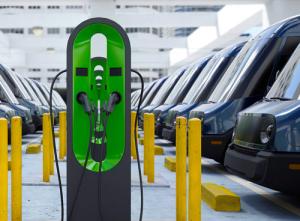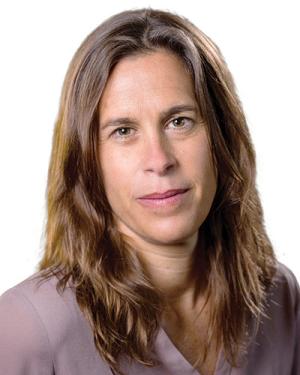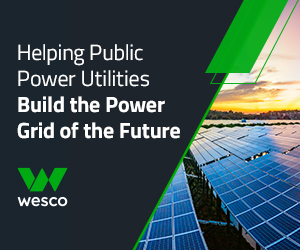EVs
David Slutzky is the CEO of Fermata Energy. Anna Demeo is Chief Product Officer of Fermata Energy.
Electric vehicle implementation heralds the future for decarbonization around the globe. But it won't be easy and there is much to bring together on the roadway to build needed infrastructure, as well as to win over the hearts and minds of the public. Fermata Energy was founded with intentions of accelerating the adoption of electric vehicles and the transition to renewable energy. With so much to know, PUF spoke with Fermata Energy CEO David Slutzky and Chief Product Officer Anna Demeo.

PUF's Steve Mitnick: What is Fermata Energy doing to accelerate the energy transformation?
David Slutzky: I started this company with two intentions. The first was to accelerate the adoption of electric vehicles and the second was to accelerate the transition to renewables on the grid as the principal source of power generation.
Those two intentions intersect at V2X technology. We call it V2X because it's not vehicle-to-everything, the grid, the building, home. Specifically, V2X includes V2G or vehicle-to-grid, V2B or vehicle-to-building, V2L or vehicle-to-load, and V2H or vehicle-to-home.
That technology sits at the intersection of those two intentions. On the vehicle side, I believe that the single biggest obstacle to scale adoption of electric vehicles now is the price. EVs are costly.
 David Slutzky: The illustrative case for why V2G or bidirectional technology is essential to scaled deployment of EVs is Texas two years ago. If you had added bidirectional vehicles to their roads, they could have discharged into critical nodes of the grid, mitigated the load crisis, and dramatically reduced the pain Texans experienced.
David Slutzky: The illustrative case for why V2G or bidirectional technology is essential to scaled deployment of EVs is Texas two years ago. If you had added bidirectional vehicles to their roads, they could have discharged into critical nodes of the grid, mitigated the load crisis, and dramatically reduced the pain Texans experienced.
It's a bit more of a premium to buy an electric vehicle relative to a comparable internal combustion engine vehicle. People buy EVs for mobility but then they park them most of the time.
So, what if those EVs while parked can earn money for owners, and at the same time they're in part providing value to other customers, such as the utilities? The total cost of ownership value proposition of an electric vehicle suddenly becomes more compelling than an internal combustion vehicle. That will accelerate deployment of electric vehicles.
On the grid side, the single biggest obstacle to scale deployment of renewables is the need for massive energy storage designed into the grid to accommodate the intermittence of generation. There were billions spent subsidizing the deployment of stationary storage over a decade and a half subject to mandates.
There was a lot of effort, and yet the scale of deployed stationary storage is dwarfed by deployed electric vehicles already on the road. With the Nissan LEAF, since it became bidirectional in 2013, and that includes the older twenty-four kilowatt-hour battery packs, to the end of 2019 had roughly the same amount of energy under its hood as the entire stationary storage industry.
 Anna Demeo: There’re only so many ways to convert power bidirectionally. There’re certain voltages. Bidirectional chargers are becoming a commodity. We look at battery health and temperature, which we have a patent on. This software platform has the intelligence to eventually work with any charger.
Anna Demeo: There’re only so many ways to convert power bidirectionally. There’re certain voltages. Bidirectional chargers are becoming a commodity. We look at battery health and temperature, which we have a patent on. This software platform has the intelligence to eventually work with any charger.
Stationary energy's grown since, and faster than the LEAF, but there are more electric vehicles coming every day. That's where the storage in EVs will come.
What's interesting about stationary storage, relative to electric vehicle energy storage, is that there's a lot of CapEx in stationary storage. With electric vehicles, the storage comes free with the leather seats and air conditioner, so it's a better value proposition.
You have to manage around the mobility utilization of that vehicle and the OEM's concerns about battery degradation because they're on the hook for eight years and a million miles. But if you can do that now, you have cost effective, large-scale deployable, and well-distributed, energy storage assets. That's where vehicle-to-grid sits at the intersection of those two intentions.
PUF: Anna, what is special about Fermata Energy?
Anna Demeo: Ten years ago, David decided to start a V2G company, and that was visionary. David's vision aligns with my mission, which is we're at a unique point in time and space, and you don't often get these opportunities to be a nexus of transformational change.
You have a grid that has been the same for over one hundred years, and now it's going to both a decentralized platform and decarbonization. Then you have mobility, moving to electrification, and buildings becoming electrified.
If you take the intersection of these three sectors, they're complementary. I am asked all the time, "If we go to all electric vehicles, won't it break the grid?" The answer is yes, if we do nothing, but it can be the solution to the grid if we do this right.
At the intersection of these three circles of mobility, electrifying buildings, and decarbonizing the grid is Fermata Energy. We sit in the center because when you try to solve the mobility — basically batteries on wheels — that's the most complicated of equations.
Fermata Energy from the beginning invested in the team to think about this problem. They built the software platform that was scalable because it wasn't just electric vehicles, it was about these wider problems and the intersection among them.
I came in to bring engineering, both hardware and software development, quality, product, and program under one umbrella. Because the thought went into it so long ago, the product they have now can scale to fulfill the vision that David started with.
PUF: David, did you design from the beginning thinking the answer has to be two-way charging?
David Slutzky: Yes. The illustrative case for why V2G or bidirectional technology is essential to scaled deployment of electric vehicles is Texas two years ago. It got cold, and they had a big load problem. If you had added a million single directional EVs to the roads of Texas at that time, you'd have added a lot more load.
But if you had added bidirectional vehicles to their roads then, they could have been deployed in a way that they could have discharged into critical nodes of the grid at critical times, mitigated the load crisis, and dramatically reduced the amount of pain Texans experienced.
V2X is happening today. Fermata Energy stands strong, as we are laser focused on not spending years doing demonstration projects and pilots. They have a place, but let's get this out commercially at scale because it's urgent and available.
Now, we have commercial deployments of electric vehicles and bidirectional chargers, making thousands of dollars per year across the country. Our role is to demonstrate beyond the R&D stage, that this is a commercially scalable, important contribution to the next generation of the power grid. And, of course, demonstrating that means making it happen.
PUF: Anna, what's inside?
Anna Demeo: There're only so many ways to convert power bidirectionally. There're certain voltages. Just like electric vehicle chargers are becoming a commodity, the bidirectional chargers are becoming a commodity item.
What's important is the software that is the intelligence behind how and when to do this. We have to look at battery health and temperature, which we have a patent on.
These are key in making sure everything works well together. This software platform has the intelligence to eventually work with any charger.
You go to a gas station today, and we're all grateful we don't have to choose which pump we need to be at, compared to which car we have. We're building a software platform that solves this equation regardless of charger or car. That's an important distinction for what Fermata Energy's done.
PUF: Talk about how you connected with utilities and are working together.
David Slutzky: We built our software platform to recognize if you're aggregating different power electronic systems with varied communication protocols and to have them function as a single unit as part of a virtual power plant or distributed energy resource.
Members of our team had built the original software platform for Duke Energy's microgrid. We've added to that team data science expertise because we have to predict behaviors of different elements.
The weather is impacting HVAC systems, which impacts load and affects battery degradation. It's a lot of variables, and that's why we developed an advanced software platform.
It took years to get the tech right, and we couldn't get anybody to make the bidirectional chargers, so we made them ourselves. We got the first UL 9741 certified bidirectional charger, right before COVID hit.
We're still the only company with this certification because it's not easy to obtain. But we decided we don't want to only be in the charger business as that will become a commodity business. AI-driven software matters.
We're partnering with most of the major charger OEMs around the world, including startups. As they pivot to make bidirectional chargers, we're helping them get through UL. We leverage their products with our software platform.
The next charger that's coming out is a twenty kilowatt 480/3-phase bidirectional charger. It's made for us by Heliox, a Dutch company. There are multiple other charger companies with products coming forward and we will be operating their chargers.
We have invested a lot of time and energy to work with utilities so that they view us as a partner.
For example, one of our earliest FE-15 bidirectional charger deployments was in Vermont on the campus of Green Mountain Power. That resulted in GMP having the first use of V2X in a utility demand response program.
Another thing that makes us unique is that we are a full member of PJM and are a registered curtailment services provider. In 2016, we bid those into the frequency regulation market of the PJM.
These are illustrative cases that include the City of Boulder in Colorado, which has a LEAF in the fleet, and they installed one of our fifteen kilowatt chargers. We operated behind-the-meter demand charge management.
We were predicting the building load and responding with a discharge from the vehicle during the building's peak period, enabling the customer to save on the electric bill by reducing the demand charges.
For that site, Boulder announced an average of two hundred seventy dollars in electric bill savings every month for a year, with a fifteen-kilowatt bidirectional charger and a LEAF.
We have a site in Burrillville, Rhode Island, formerly in National Grid's territory (now Rhode Island Energy). Through their ConnectedSolutions demand response program, we participated for ten weeks during the summer, and each of the last two summers, we had a LEAF operating as a fleet vehicle and one of our chargers at a wastewater treatment plant, discharging energy stored in the EV battery into the utility system in response to a signal.
The EV made four thousand two hundred dollars for the customer over a ten-week period — while being parked and without disrupting drive times. This summer, the value of that program is up to four hundred dollars per kilowatt when integrating with DERMs.
We're going to have twenty kilowatt chargers, and those could make eight thousand dollars for our customers participating in a summer demand response program, being utilized nominally in terms of battery degradation because it's just a few dozen events over the year. That's disruptive income for our customers.
This is a lucrative opportunity for our customers. There are over five million U.S. commercial customers with demand charges above fifteen dollars per kilowatt.
Most are good places for this technology to reduce the electric bill. We're delivering to utilities initially by supporting demand response programs, both behind and in front of the meter.
As this technology grows, we can address other pain points utilities have, but for which there isn't an active monetization mechanism to access this value. We're working with utilities and regulators to figure out how to monetize other value streams.
The single biggest value we bring from a bidirectional vehicle and charger is backup power.
When those chargers become available to residential customers, they or the utilities will be happy to purchase those assets so they can shed system-wide load.
They then can back up power of their home when the grid goes down. When it's not down, they could be engaged in commerce, at the grid or utility level.
PUF: You've mentioned the Nissan LEAF, but I suppose it would work with other EVs.
David Slutzky: Up until a year or so ago, the only bidirectionally-enabled vehicles in the U.S. market were the LEAF and the Mitsubishi Outlander. The Outlander hybrid had a smaller pack, although this year it's a bigger pack.
Now and in the coming months and years, more bidirectionally-enabled EVs are coming online and we are working with a number of OEMs to ensure that our platform is compatible with their bidirectional technology.
We're working with Ford to do bidirectional charging. Most of the major OEMs in the last two years have said, "We're going to be bidirectional." They see opportunity for recurring revenues for their customers. They see that if their vehicles can't make money, but competitors can, they'll lose the race.
PUF: Anna, what will you be working on in the next year or two to bring this to market?
Anna Demeo: As mobility moves to electrification and electrification moves to bidirectional, you're going to see steep increase of adoption. When Fermata Energy started, we went to market on the commercial side, because of those demand charges and early adopters tend to be in the fleet and commercial space.
That's going to turn to residential. The Department of Energy said eighty percent of all electric charging will happen at home. Our country's whole load profile is going to change.
It's a triple win. It's a win for the consumer who gets resiliency, for utilities with a way of managing electrification of mobility, for companies like Fermata Energy and OEMs as they invest time, money, and resources to build out a new platform.
The Fermata Energy team will continue to grow with the OEMs, making sure our platform works with everyone, offering the right set of features, including resiliency for all cars on the residential space.
PUF: How can commissioners and utilities find out more?
David Slutzky: Utilities and regulators are part of Fermata Energy's mission. Fermata Energy was founded by an academic to try and put knowledge out for the world to benefit from. We are a conduit for that.
The regulators can help move some of the obstacles out of our way. One of the challenges is this is a grid-tied technology. We bump up against the interconnection process and we're typically behind a significant load.
An EV is not going to go beyond the building load, yet we might have to wait sometimes in a six-month or even two-year queue to have the upstream infrastructure evaluated for the interconnections. That's when it isn't even applicable if you have the right amount of charging done behind the building meter.
If regulators can work with utilities to enable streamlined interconnection processes, this technology will scale more quickly. Further, utilities need to recognize the enormous value to ratepayers of the cost of energy storage from a mobile asset as compared to stationary storage.
For example, in California there are SGIP credits, which are subsidies for stationary storage; but we're not eligible because the technology's too new. The regulatory environment is slow in the utility space.
There are missed opportunities to accelerate accessibility of this massive dispatchable capacity that regulators and utilities could be focused on. We would be thrilled to support that.
When I talk about stationary storage relative to mobile storage, a Nissan LEAF has the equivalent of 4.5 Powerwalls under the hood. It's free when you buy the car. A Ford F-150 is about eleven Powerwalls under the hood. It's cost-effective but EVs are not getting the same subsidies.
Some regulators are limiting charger eligibility for funding to CCS chargers, which isn't a standard yet. It's a sort of standard, but OEM implements it differently.
There are challenges with V2X using CCS right now, and that'll get sorted out in the next couple of years. We're working on that. However, in the meantime, premature pivoting to CCS may well delay the deployment of enormous dispatchable capacity that is available now with bidirectionally-enabled EVs.
Today, there's the LEAF and Mitsubishi Outlander, all Teslas, and other vehicles can charge with a CHAdeMO charger. But federal and some state regulators are trying to get rid of CHAdeMO, and it's the one that works now. What regulators should do is stay technology neutral.
Driving the EV Revolution articles at fortnightly.com:



